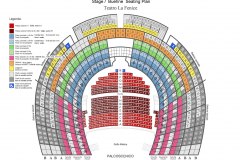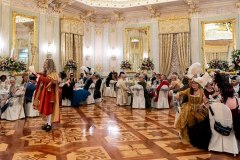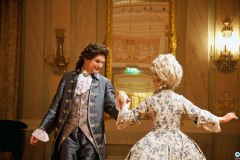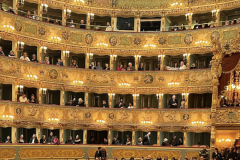Ballo Tiepolo
March 2025 | ||||||
|---|---|---|---|---|---|---|
Mo | Tu | We | Th | Fr | Sa | Su |
BALLO TIEPOLO
The Venetian Carnival Ball, an International appointment since 1998
The Tiepolo Ball, at its 26th edition, is set in the cultural heart of Venice: La Fenice Theatre, specifically in the halls historically dedicated to dance and entertainment, the Apollonian Halls. They were dedicated to the God of Sun Apollo, with clear reference to Louis XIV, the Sun King of France, great patron saint of ballet and the arts, which inspired the opening show.
The guests will be welcomed by a rich aperitif in the foyer of the theatre followed by a rich DINNER in the Apollonian Halls. During the evening the CLASSICAL ORCHESTRA will create a lovely atmosphere together with the opera singers, dancers and the various performers who will perform on the stage of the main Apollonian hall and will move between the tables of the Ammannati Hall, dwearing sumptuous costumes created by the Atelier Tiepolo.
The menu, created ad hoc and with attention to details by our chef, will present fish dishes. For those who prefer a vegetarian or meat menu, can indicate it at the time of booking.
After dinner, the GRAND BALL will begin in the foyer of the theatre. There, the Dance Master with his partner will involve the guests in the historical dances of the European courts, and the orchestra will accompany them. Between dances, guests can enjoy hot chocolate, Venetian fritters and Prosecco.
It is compulsory to wear a PERIOD COSTUME, which can be rented at the ATELIER TIEPOLO .
LA FENICE THEATRE
Since its construction in 1792 by the architect Giannantonio Selva the style of the Gran Teatro La Fenice is the neoclassical style then resumed also by Giambattista Meduna for the restoration of 1854; this style appears 'old fashion' for the time, but dusting off the art of the late eighteenth century, Meduna hopes to be able to conserve in this theatre the memory of an era in which Venice was still great. He wanted to remove the specter of decadence in which the city was pouring, even for the time of a show.
APOLLONIAN HALLS
The Apollonian Halls, also in neoclassical style, have always been the beloved place of the city as a ballroom, venue for concerts and, in more recent times, venue for cultural initiatives. The dinner will take place in the Main Apollonian Hall and in the Ammannati Hall.
DRESS CODE: PERIOD COSTUME, available for rental at the ATELIER TIEPOLO
Program and cast
Evening program
8 p.m.: opening of the doors of the theatre and aperitif in the foyer
8.30-8.40 p.m.: access to the Apollonian halls to enjoy dinner
9 p.m.: music and entertainment with the show in the Main Apollonian Hall and interactive performances between the tables
11.30-11.45 p.m.: end of dinner and opening of the bar in the foyer for coffee, carnival doughnuts and Prosecco wine
11.45 p.m.-12 a.m.: Grand Ball in the theatre’s foyer
Teatro La Fenice
Teatro La Fenice ("The Phoenix") is an opera house in Venice, Italy. It is one of the most famous theatres in Europe, the site of many famous operatic premieres. Its name reflects its role in permitting an opera company to "rise from the ashes" despite losing the use of two theatres (to fire and legal problems respectively). Since opening and being named La Fenice, it has burned and been rebuilt twice more.
The Teatro La Fenice was founded in 1792. In the nineteenth century, the theatre staged the world premieres of numerous operas, including Rossini’sTancredi, Sigismondo and Semiramide, Bellini’s I Capuleti e i Montecchi (The Capulets and the Montagues) and Beatrice di Tenda, Donizetti’sBelisario (Belisarius), Pia de’ Tolomei, and Maria de Rudenz, and Verdi’s Ernani, Attila, Rigoletto, La traviata and Simon Boccanegra.
In the last century, the Fenice has also placed a special emphasis on contemporary productions, welcoming the world premieres of Stravinski’s The Rake’s Progress, Britten’s The Turn of the Screw, Prokofiev’s L’angelo di fuoco (The Fiery Angel), Nono’s Intolleranza (Intolerance) and Maderna’s Hyperion. Recent premieres have included Kagel’s Entführung im Konzertsaal (Kidnapping in the Concert Hall), Guarnieri’s Medea, Mosca’s Signor Goldoni and Ambrosini’s Il killer di parole (The Killer of Words).
With a seating capacity for over one thousand people, the Fenice boasts excellent acoustics (which were improved when the theatre was rebuilt after the devastating fire of 1996), a 98-member orchestra and 66-person opera chorus, a dedicated local audience and a large international following. The theatre is a leading creative venue, staging more than one hundred opera performances per year, a major symphonic season conducted by prominent conductors from across the globe (including frequent collaborations with Myung-Whun Chung, Riccardo Chailly, Jeffrey Tate, Vladimir Temirkanov and Dmitrij Kitajenko), the full cycles of symphonies by Beethoven, Schumann, Brahms and Mahler, a contemporary repertoire focused especially on Venetian artists such as Nono and Maderna, ballets, and chamber music concerts.
The theatre is owned by the Municipality of Venice and managed by the Fondazione Teatro La Fenice, a private body whose members include the State of Italy, the Veneto region, the Municipality of Venice and numerous public and private institutions. The foundation also runs a second theatre, the Teatro Malibran (formerly known as the Teatro di San Giovanni Grisostomo), which dates back to 1678.
The leadership of the Fondazione includes General Manager Cristiano Chiarot, Artistic Director Fortunato Ortombina, Principal Conductor Diego Matheuz and Chorus Master Claudio Marino Moretti.
Transport
Vaporetto
from Tronchetto: line 2
toward Rialto bridge, St Mark and Lido
from Piazzale Roma and the Santa Lucia train station: line 1 or line 2
toward Rialto bridge, St Mark and Lido
stops: take line 1 to Rialto bridge, St Angel, St Samuel or St Mark (Vallaresso);
or take line 2 to Rialto bridge or St Mark (Vallaresso)
Alilaguna public transportation service from the Marco Polo airport - take the orange line to Rialto bridge or the blue line to St Mark (Vallaresso)
Parking: although you can drive to Venice, cars, bicycles and mopeds are not permitted in the city. You can leave your vehicle in one of the parking garages on Tronchetto or in Piazzale Roma:
Entrances
La Fenice Opera House has two entrances:
- the stage door is for theatre staff and performers only and is manned by a doorman;
- the main entrance
Lifts
The boxes, gallery and family circle can be reached via elevators
Access
The theatre complies with all legal regulations regarding special needs accessibility.

 EN
EN DE
DE IT
IT FR
FR ES
ES RU
RU JP
JP RO
RO
 Seating plan
Seating plan 



